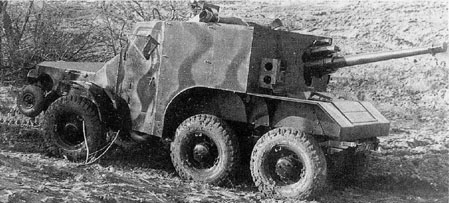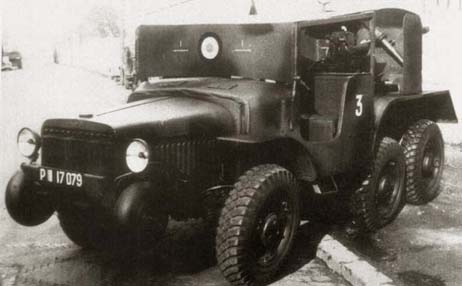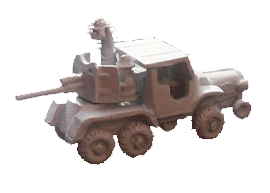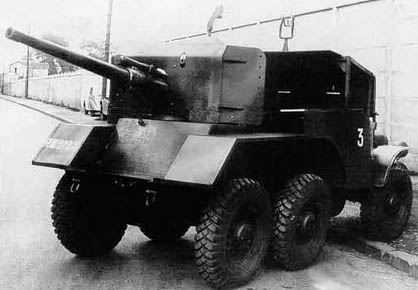Laffly W15 TCC
Self-Propelled Anti-Tank
Gun
Description
The Laffly W15T (T being short for tracteur) was a 6x6
artillery tractor use to tow the 47
SA 37 anti-tank gun.
After the
start of the war, it was
realised that a self-propelled mount for the 47mm mle 37 anti-tank gun
was
required. In a quick but rather desperate response, the W15T chassis
was coupled with the 47 SA 37 as the Laffly
W15TCC (CC being short for chasseur de chars, tank hunter). I have
chosen to use the literal translation "tank hunter" rather than its
americanized form "tank destroyer".
The prototype was fully armoured but because of the urgent
need,
the production versions of these only had armoured protection for the
cab an extended gun-shield. They proved very successful in combat.

Fully armoured prototype
Development
Laffly-Hotchkiss vehicles included cars, ambulances, tankers,
carriers, and prime movers and were more often than not designed by
Laffly but with Hotchkiss engines and often manufactured by both
companies. Almost all the larger military vehicles (including the W15T)
featured a set of small front wheels and another
set suspended beneath the driver's cab to help the vehicle
overcome
obstacles.
In October 1939 the need for a self-propelled
anti-tank gun became clear and Gereral Keller, the Inspector General of
French Tanks proposed the idea of mounting the 47mm mle 37 anti-tank
gun on an armoured cross-country chassis. On 6th December 1939 the
project was excepted and the Laffly W15T 6x6
all-terrain truck truck
chassis was chosen. The cab was fully armoured and an armoured box on
the bed of
the truck enclosed the gun. The 12-15mm gave reasonable protection to
the crew and was comparible with the armour on the equivalent German
weapon; the self propelled 4,7cm PaK(t) on the PanzerJager I. The first
off-road trials of the fully armoured prototype took place on 2nd March
1940 followed
by firing tests on the 4th. Trials were successfully completed
on 12th
March and the following day the W15TCC tank hunter was accepted by
the army. On 6th May an intercom system was installed using throat
microphones.
On 17th May the fast advance of the Panzer Divisions
preciptated and order for 50 vehicles, because of the urgency
it was decided to reduce
the armour. It was neccessary to get them to front in time to
make a
difference, regardless of how well they were protected. The cab was
only partially armoured and included
an armoured windscreen which could be lifted when not in combat to make
driving easier. Instead of boxing in the gun, it recieved an enlarged
gun-shield to protect the crew. Again 12-15mm plate was used. The first
vehicles were delived on 25th May, only 8 days later. They were then
produced at a rate of five vehicles every two days, a total of 70
vehicles being delivered to the army.

Production model with partilly
armoured cab
and enlarged gun-shield.
Operation
The 47mm anti tank gun
had a practical range against tanks of 1,000m, a distance an enemy tank
could cross in only a few minutes.A self propelled gun would have a
considerable advantage over the towed gun in that it could be in
position and ready to fire in only a few seconds, fire a number of
shots, and then move quickly to a new firing position. The W15TCC,
although lightly armoured, was fast and proved very good at these hit
and run tactics.
Had these vehicles been developed sooner and deployed more
widely, it is not unreasonable to believe that the French would have
been far better able to cope with the Panzer Divisions slicing
through Northern France.

W15TCC by by Pithead Miniatures.
54th BACA 11th RA
The 54th BACA
11th RA under the
command of sous-lieutenant
(Sub-Lieutenant) Brussaux
recieved its five W15TCC tank hunters on 29th May 1940. As quickly
as 5th June, the tank hunter platoon is in action deployed on
the Belloy
heights near Abbeville on the River Somme. That evening, about 20
German light tanks are spotted on the road to Abbeville and
the French open fire with their 47mm guns at a range
of 2,000m. Two German tanks are immediately knocked out and catch fire.
A futher two tanks are reported knocked-out and
immobilized.
On 6th June, the 54th BACA is deployed to block the Abbeville
road down which 50 enemy tanks are seen advancing. The first W15TCC
destroys three advancing Panzer IV tanks and then retires drawing the
pursuing Germans into an ambush by two supporting W15TCCs. These open
fire and a further 6 tanks are destroyed and 4
others knocked-out and immobilized. The Germans advance on
foot and are driven off by
the defensive fire from the French crew's Thompson submachineguns.
The German Panzers retire and decide to bypass this resistance
and leave it to the folllow-up troops to mop-up. The senior officer
present, commandant (Major) Decoux of the 7th Dragoons
reported 18 tanks knocked-out but sous-lieutenant
Brussaux only saw 9 burning and 4 knocked-out. The French lost
one W15TCC due to mechanical breakdown which was then destroyed by its
crew. They had no other casualties.
On 7th
June the platoon is in Campaux. The AA and Services platoons
are ordered to retire to Saint-Aubin. The
Hotchkiss 25mm AA guns are towed by trucks even though they have a good
anti-tank capability they cannot keep up with the W15TCCs hit
and run tactics. Although these hit and run tactics are not the
prescribed
doctrine, they seem to be working. The tank hunters operate in
pairs 10-15km in front of the French main line
of restistance. The W15TCCs open fire at the advancing Germans, inflict
as much damage as quickly as possible, and then retire to avoid being
encircled.
Enemy tanks are reported north of Campaux
and the platoon is split into two pairs. Two W15TCCs under
sous-lieutenant Brussaux watch the Gournay road and
the
remaining two under adjudant (Warrant Officer) Marchal
watch the Hernemont and Gournay roads.
Sous-lieutenant Brussaux with the help of a
supporting infantry company spots the advancing Panzer IVs. He opens
fire from ambush at a range of only 100m and destroys all three
tanks. Brussaux's second tank hunter had problems with its
guns traverse and retires. Brussaux's remaining vehicle is
sonn afterwards surrounded by 30 German armoured cars. He opens fire,
two burn and three are knocked-out causing the Germens to decide
that discretion is the better part of valor and retreat. AT close of
play, with no enemy armour in sight, Brussaux retires as
planned.
Using a supporting armoured-car as a decoy, adjudant Marchal
lured the German tanks into an ambush by the two tank hunters. These
open fire with their 47mm guns and destroy two tanks and knock-out a
third before retiring as planned.
The 54th BACA reunites at Versailles where it joins the 7th
Régiment de Cuirassiers. Brussaux had hoped to
repair his vehicles
at the Laffly factory, but there was no time, so with only two
fully-operational tank hunters the 54th BACA moves to Vannes where it
joins capitaine Etienne's company of 9 W15TCCs.
Finally on June 12th, they are encircled by the advancing
Germans, and
after attepting to break out over the River Loire they scuttle their
vehicles and flee on foot.
During its eight-day fight the 54th BACA destroyed
28 tanks and 5 armoured cars.

Deployment
The Laffly W15TCC were issued to the mobile
anti-tank batteries (BACA).
The mobile
anti-tank batteries (BACA) had one anti-tank platoon
and one anti-aircraft platoon. A battery had 3 officers, 21
NCOs and 64 men and was organised as follows:
- Tank Hunter platoon
- 1 Laffly V15R all-terrain liaison vehicle
- 5 Laffly W15
TCC
- 3 Unic TU1 tractors
with 3 mle1937 infantry trailers carrying 200 47mm AP [1]
- 2
motorcycles
- 25mm AA platoon
- 3 25mm Mle1939 Hotchkiss AA guns (these could be used
against both air and ground targets) [2]
- 3 Laffly
W15 T
(towing the gun and carrying ammunition and the crew)
- 1 Laffly W15 T (recovery/extra ammuntion)
- 1 5 tonne
ammunition lorry with 3200 25mm rounds
- 1 liaison vehicle (Peugeot 402 car?)
- 2 trucks
- 2
motorcycles
- 1 bicycle (transported on a truck during movements)
- Service platoon
- 1 Laffly S25 T (recovery vehicle)
- 2 trucks
- 2
lorries
- 1 field kitchen (towed)
Notes:
- Some sources say 2
- Some sources say 4
10th May 1940
When the Germans's attacked the French army had no BACA
formed. They were administratively, but not
operationally, part of the 11th RA.
They were created after the German invasion as follows:
May 1940:
- 51st BACA 11th RA: 5 W15TCC (part of 4th DCR)
- 52nd BACA 11th RA: 5 W15TCC (part of 4th DCR)
- 53rd BACA 11th RA: 5 W15TCC (part of 2nd DCR)
- 54th BACA 11th RA: 5 W15TCC
- 55th BACA 11th RA: 5 W15TCC (renumbered 11/77e on 5th June)
June 1940:
- 56th BACA 11th RA: 5 W15TCC
- 57th BACA 11th RA: 5 W15TCC (part of 3rd DCR)
- 58th BACA 11th RA: 5 W15TCC
- 59th BACA 11th RA: 5 W15TCC
- 60th BACA 11th RA: 5 W15TCC
- 61st BACA 11th RA: 5 W15TCC
- Centre d'Organisation de l'Artillerie (COA) Nemours: 6
W15TCC
- Group Vannes: 9 W15TCC
Technical Data
| Manufacturer |
Laffly (1940) |
| Quantity |
May 1940: 70 |
| Weight |
48.8 tons, 4.96 tonnes, 4,960kg |
| Length |
4.50 m (14' 9") |
| Width |
1.90 m (6' 3") |
| Height |
1.80 m (5' 11") |
| Main |
47mm SA37 anti-tank gun |
| Secondary |
7.5mm FM 24/29 machine-gun on an anti-aircraft mount
Thompson SMG |
| Elevation |
-13° to +13° |
| Traverse |
60° to the rear |
| Ammunition |
Main: 30 AP (plus 120 shells in Unic TU1 tractors)
Secondary: 1000 MG plus 500 SMG |
| Driver's Cab |
12-15mm |
| Extended Gun-Shield |
12-15mm |
| Engine |
Hotchkiss 680 2.3 litre, 4 cylinder, petrol, 65 HP |
| Speed (Road) |
48 km/h (30 mph) |
| Speed (Cross-Country) |
34 km/h (21 mph)
|
| Range (Road) |
|
| Range (Cross-Country) |
|
| Crew |
4: Driver, Commander (NCO), Gunner, Machine Gunner |
| Radio |
None |
| Other nations |
|
| 




